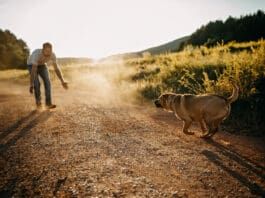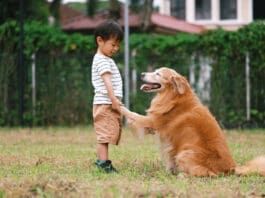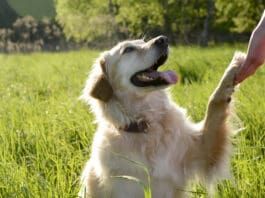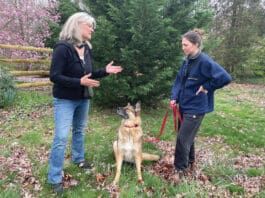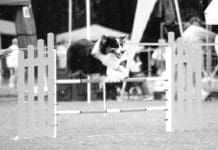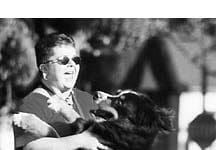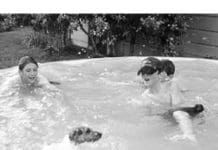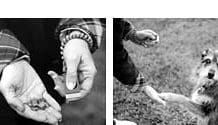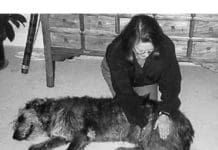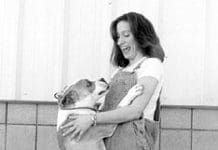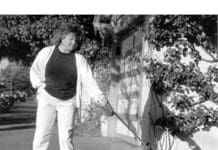Dog Athlete Massages for Pre- and Post-Activity
Dogs love a good massage. If you don't believe me, ask any dog. Slow rhythmic massage moves can improve circulation, reduce stress, and relieve discomfort from a recent injury or a chronic condition like arthritis. But there is another type of massage that we sometimes overlook. Prior to a competition, an invigorating sports massage can do wonders to get a canine athlete physically pumped and mentally psyched. This is true for any competitive endeavor whether it is lure coursing, agility, obedience, Frisbee, fly-ball, tracking, herding, field trials, or some other activity. After the competition, the dog can definitely benefit from another, more relaxing sports massage.
Promoting Positive Training Methods
Every so often, at a training demonstration or event promoting positive training methods, a skeptical spectator will ask me whether positive training methods can be used for preparing dogs for all types of careers. I know where they are usually going with this question. Their real question is, “I know you can teach dogs to do cute little tricks with treats and stuff, but what about when you want a reliable dog, like an obedience competitor, a protection dog, or a police dog?” Their assumption is that in order to teach a dog to respond without fail, to sharply execute the handler’s every command, you will have to use force- and fear-based methods at some point in the dog’s education.
Rally Obedience Classes for Dogs
I used to show my dogs in competitive obedience. In the beginning, the opportunity to earn obedience titles and show off my dog's training appealed to me greatly. But as I evolved toward positive training methods and a more fulfilling relationship with my dogs, the military precision of the show ring lost its charm. I realized that it made no sense to have a relationship with my canine pals based on warm interaction and communication outside the ring, only to march in cold silence next to my dogs inside the ring. I stopped showing and turned my efforts toward family dog training and activities that were more fun and flexible, like agility and canine freestyle.
Swimming is Great Exercise for Dogs
Tucker, our six-year-old Cattle-Dog mix, loves to swim. Every morning when we walk the quarter-mile down our driveway with our four-pack of dogs to pick up the Chattanooga Times-Free Press, Tucker casts longing glances at the pond in our next-door-neighbor’s front yard. As long as we occasionally remind him to stay with us, he’s fine. But if we let our attention lapse for too long, especially if it’s a particularly warm day, a loud “Splash!” announces in no uncertain terms that Tucker has once again gone for an unauthorized swim. You would never know that Tucker used to hate the water, and that we had to make an effort to convince him to give recreational swimming a try.
Proper Use of Head Halters for Leash Training
Ten years ago, a new dog training tool hit the market. Known generically as the head halter (or head collar), it is a device similar to the halter commonly used on horses. It provides a greatly increased degree of control over the dog who is dedicated to pulling on the collar and leash, without the punishment or pain factors associated with choke chains and prong collars. The head halter has a strap that goes around the dog’s nose, and another that clasps around his neck, just behind the ears. The leash attaches to a ring below the dog’s chin. Just like with halters on horses, bulls and other large animals, it works on the principle that where the nose goes, the body must follow.
How to Keep Dogs Off the Couch
One of the best things about being a WDJ product review writer is having the opportunity to play with all the fun stuff that we review. As a professional trainer, it helps me in my business, too, to be able to try out new products before I invest in them myself (or encourage my clients to buy them). So it was with great interest and curiosity that I agreed to test products designed to keep dogs “off” or “away from” forbidden furniture, counters, or other areas of the house. I must have been temporarily senile; for a moment I forgot how very opposed I am to most aversive training tools. When the products arrived and I removed them from the box I immediately realized my ethical dilemma.
Clicker Training and Trick Training Your Dog
one
can shape a new trick."
can shape a new trick."
Tail-Wagging Training
Training, says Massachusetts dog trainer Donna Duford, should be fun, not work. Her seminars are such upbeat, tail-wagging events that the dogs seem to be having a party. Look closer and you’ll see a serious class, with participants taking notes as Duford reviews the laws of learning and defines classical conditioning, operant conditioning, positive and negative reinforcement, positive and negative punishment, continuous and variable reinforcement schedules, and other fundamentals of behavioral training.
Compression Techniques for Muscle Strength
All dogs love a gentle pat on the shoulder or the rump. To them it can be a signal of a job well done or simply an indication of our affection. Touch strengthens the bond between dog and owner and is a basic building block of the canine-human relationship. We have already considered effleurage, the open-hand technique that resembles smooth petting strokes yet does so much for the dog’s circulation, relaxation, and balance. Compression, another open-hand technique, also affords enjoyable physical contact between you and your dog while providing important health benefits to your canine friend.
Whole Dog Journal on Training Books and Videos
Sixteen years ago, Karen Pryor’s paradigm-shifting paperback book, “Don’t Shoot The Dog,” made an unobtrusive entrance into the dog training world, drilling the first noticeable hole in the massive dike of traditional, force-based training. Over the years, dog owners and trainers with positive training philosophies thirsted for more information. The response was a maddeningly slow trickle of books and videos, most notably from Ian Dunbar, Karen Pryor, and Gary Wilkes.
Training Your Dog Not to Jump Up On You
I have a 1 1/2 year old Labrador Retriever. She is very smart – and very stubborn! My husband and I have been to puppy school, obedience school and we have also worked with a personal trainer. She does the “normal” puppy things – jumping up when I come home from work and when people come to visit, etc. But one of the reasons we went to the trainer was because she seemed to be exhibiting some aggressive tendencies.
Training Foster Dogs to Walk Properly On-Leash
My husband and I acquired two (temporary) canine foundlings last week. Julie is a five-month-old purebred Akita puppy that we rescued from our local shelter, where her cage card identified her as a Shepherd/Husky mix. Her prospects for adoption were dismal, given that the shelter euthanizes 85-90 percent of incoming animals. Our second castaway, Princess, is a three-year-old Beagle mix. My husband and I were driving down a busy highway when we spotted her, hunched in the middle of the road, defecating while cars swerved around her on both sides. Princess was wearing a collar and tag, but her owners had moved, and she ended up staying at our house for several days while we tracked down their new phone number and location.



